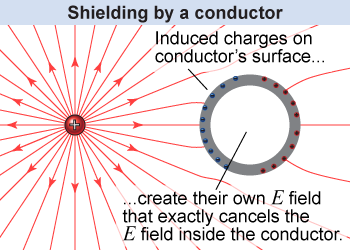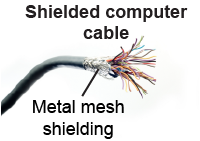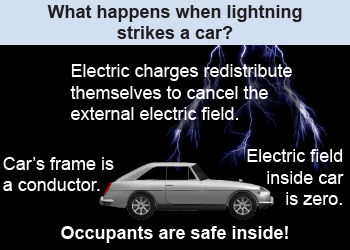|
Low-intensity electric fields are almost always present in our environment. Every wire in your house generates electric fields, as does every atmospheric lightning bolt. Cellphones, wireless networks, and radios are sensitive to these fields. Dropped cellphone calls and static are partially caused by interference from stray electric fields. Fortunately, there is a way to shield against stray electromagnetic fields. 
|
 An electrical conductor, such as a metal, is a material in which charges are free to move. Consider what happens to a conductor placed in an electric field. Because they can move, charges feel the electric force and respond by moving almost instantly. The charges rearrange themselves so that the electric field inside the conductor is zero!
An electrical conductor, such as a metal, is a material in which charges are free to move. Consider what happens to a conductor placed in an electric field. Because they can move, charges feel the electric force and respond by moving almost instantly. The charges rearrange themselves so that the electric field inside the conductor is zero!
Why is the field inside zero? 
|
The field is zero because, if it were not zero, the charges in the conductor would continue to feel electric forces and continue to move in response. The charges in a conductor only stop moving when there is no longer any electrical force acting on them. When the electric force is zero inside the conductor, the rearranged charges have created an additional electric field that exactly cancels out the external electric field. This effect is called shielding. 
 |
The electric field is equal to zero everywhere inside a conductor that is in electrostatic equilibrium—i.e., a conductor that is not carrying electric current. This result is a consequence of Gauss’s law, which you will learn about in a more advanced course in physics. One way of stating Gauss’s law in words is that “the electric flux through a closed surface is equal to the charge inside the surface divided by the permittivity.” As you will learn in the next section, a conductor in which no currents are flowing must have a constant electric potential everywhere, so there cannot be any electric flux through the surface of that conductor. By applying Gauss’s law we see that there cannot be any net charge inside the surface!
Even though you don’t know it, you’ve already seen Gauss’s law in one form: Coulomb’s law! Using calculus, Gauss’s law and Coulomb’s law can be derived from each other. 
|
 Computer network signals can be corrupted by stray electric fields. To prevent this from happening, all computer network cables have a conducting metal layer surrounding the signal wires inside. The metal layer shields the wires from stray electric fields.
Computer network signals can be corrupted by stray electric fields. To prevent this from happening, all computer network cables have a conducting metal layer surrounding the signal wires inside. The metal layer shields the wires from stray electric fields. 
|
The English scientist Michael Faraday in 1836 invented the Faraday cage. A Faraday cage is made of a conductor and uses the shielding effect to protect whatever is inside from external electricity and electric fields. A Faraday cage can be struck directly by lightning, yet a person inside is completely safe. 
|
 If you are driving through a lightning storm, the safest place to be is inside a metal car. The reason is not that the car’s rubber tires are insulators. The correct reason is that the car’s metal shell is a Faraday cage. If lightning were to strike the car, electric charge would redistribute itself around the outside of the car’s metal shell to cancel out the electric field inside the car, leaving the interior safe.
If you are driving through a lightning storm, the safest place to be is inside a metal car. The reason is not that the car’s rubber tires are insulators. The correct reason is that the car’s metal shell is a Faraday cage. If lightning were to strike the car, electric charge would redistribute itself around the outside of the car’s metal shell to cancel out the electric field inside the car, leaving the interior safe. 
|
Imagine zapping a metal sphere with a million volts of electricity. How does the electric field inside the sphere differ if the sphere is hollow versus solid?
 |
The field inside the sphere is the same in both cases: zero! The shape of an object is irrelevant, as is whether it is hollow or solid. As long as the object is a conductor (and is in electrostatic equilibrium), then the electric field is zero everywhere inside it! 
|

